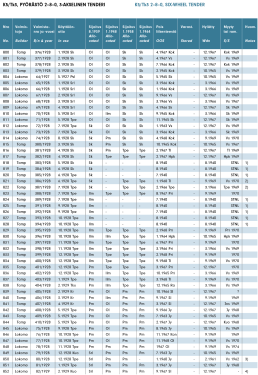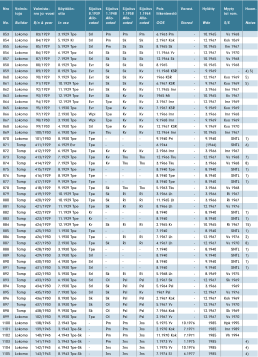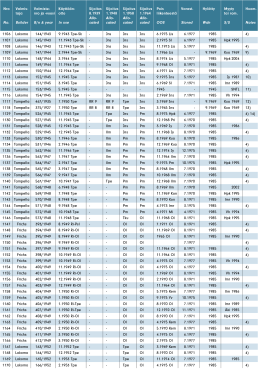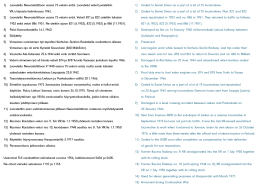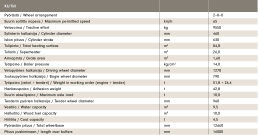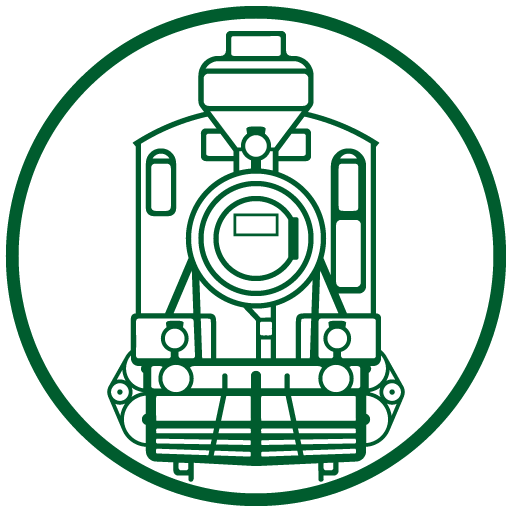Tk3-veturi 814 Seinäjoen varikolla 17.6.1958. Tällainen tenderin tiivis lisälaudoitus kehitettiin turvelämmitystä varten.
Tk3 no. 814 stands at Seinäjoki MPD on 17 June 1958. Such closely spaced plank frames for the tender were originally designed for peat fuel.
Kuva Ian G. T. Duncan / Photo Ian G.T. Duncan
K5-veturi 801 edustaa vanhinta K5/Tk3 sarjaa vuodelta 1928, valmistajana suomalainen Tammerfors Linne- & Jern-Manufaktur Aktie-Bolag (Tampereen Pellava- ja Rautateollisuus Oy).
No. 801 belonged to the oldest batch of the K5 class 2–8–0s built in 1928 by Tampella.
Kokoelma Olavi Kilpiö / Olavi Kilpiö collection
Junapainojen kasvaessa eivät K1–K2/Tk1–Tk2- eivätkä G8/Sk6-veturit enää 1920-luvun lopulla olleet riittävän tehokkaita tavaraliikenteeseen. Näillä vetureilla oli hoidettu K22–K25-kiskopainoisten rataosien tavaraliikenne sekä järjestelyjunaliikennettä muillakin rataosilla. K3–K4/Tv1–Tv2-sarjat olivat osoittautuneet onnistuneiksi veturityypeiksi, mutta ne olivat liian raskaita kevyesti kiskotetuille rataosille. K3–K4-sarjojen vastineeksi kevytrakenteisille radoille suunniteltiin aiempia K1–K2-sarjoja oleellisesti kookkaampi veturisarja K5, vuodesta 1942 lähtien Tk3. Lokomo ja Tampella rakensivat niitä yhteensä 100 veturia vuosina 1927–30. Niille annettiin numerot 800–899. Valtionrautatiet sai siten ratkaisevan parannuksen K22–K25-ratojen vetokalustoon.
Käytössä suosituksi tullut veturisarja supistui, kun talvisodan jälkeen vuonna 1940 Neuvostoliitolle toimitettiin luovutetulle alueelle kuuluvina veturit 818–822, 824–828, 870, 874–877, 882, 883 ja 885–891. Niistä saatiin jatkosodassa takaisin 874 ja 887. Veturi 871 jäi sotatoimialueelle vuonna 1944. Sota-ajasta johtuneet raaka-aineiden hankintavaikeudet haittasivat sarjan lisähankintoja. Kotimaiset veturitehtaat Lokomo ja Tampella rakensivat suurin vaikeuksin veturit 1100–1116 ja 1129–1146 vuosina 1943–48. Vetureiden 1117–1128 tilaus peruuntui toimitusvaikeuksien takia. Vajaan kuukauden käytössä ollut 1115 luovutettiin Neuvostoliittoon sotakorvausten viivästymissakkoina toukokuussa 1945.
Seuraavat veturit, 1147–1166, rakensi veturitehdas Frichs Århusissa Tanskassa vuonna 1949. Ne koottiin Valtionrautateiden Hyvinkään konepajassa. Rauman yksityisen rautatien oston yhteydessä vuonna 1950 Valtionrautatiet sai kaksi Tk3-tyyppistä veturia, joille annettiin numerot 1117 ja 1118. Veturit 821, 822 ja 886 palautettiin Neuvostoliitosta vuosina 1951–52 korvauksena Suomen ja Neuvostoliiton välisessä liikenteessä käytetyistä Valtionrautateiden tavaravaunuista, joita ei saatu palautettua Neuvostoliitosta. Lokomolta tilattiin vielä neljä veturia, numerot 1167–1170, jotka saatiin käyttöön vuosina 1952–53.
Kuriositeettina voidaan mainita, että Neuvostoliitossa rakennettiin kaksi suunnilleen K5/Tk3:n kaltaista veturia, ilmeisesti käyttäen Viipurin konepajalla olleita varakattiloita ja muita varaosia.
K5/Tk3:ssa oli aiempien K/Tk-sarjojen pyörästöjärjestys, yksiakselinen kiertyvä teli ja neljä vetoakselia. Vetureissa oli kankikehys, Walschaertin luistikoneistot, mäntäluistit ja tulistimella varustettu kattila, jossa ensi kertaa Suomessa oli 14 kg/cm² työpaine. Vetureista osa valmistui poistohöyryimurilla ja osa ainoastaan tuorehöyryimureilla varustettuna. Vanhempi 800-sarja varustettiin Aga-valaistuksella ja uudempi 1100-sarja sähkövalaistuksella. K5/Tk3-veturit olivat valmistuessaan halkolämmitteisiä. Neljännesvuosisadan mittaisesta hankinta-ajanjaksosta johtuen 800-sarjan vetureissa oli rakenne-eroavuuksia 1100-sarjaan verrattuna. Sota-ajan materiaalivaikeudet vaikuttivat osaltaan eroja lisäävästi ja Tanskassa rakennetuissa vetureissa käytettiin varustimia, jotka poikkesivat Suomessa rakennettujen vetureiden vastaavista.
Vetureihin tehtiin niiden käyttöaikana suhteellisen vähän muutoksia. Poistohöyryimurit 800-sarjan vetureissa vaihdettiin toiseen malliin vuosina 1930–39 ja niitä alettiin vaihtaa tuorehöyryimureiksi vuodesta 1946 alkaen. Osaa Tk3-sarjasta käytettiin märkähöyryvetureina vuosina 1944–45 tulistinvetureiden luistien ja sylinterien voitelussa käytetyn tulistajaöljyn saantivaikeuksien takia. Vain muutama 1100-sarjan vetureista muutettiin hiililämmitteiseksi, kun taas 800-sarjan vetureita muutettiin useaan kertaan hiili- tai halkolämmitteisiksi. Osaan 800-sarjan vetureista vaihdettiin sähkövalaistus vuosina 1952–63.
K5/Tk3:t sijoitettiin ensin muutaman kuukauden ajaksi koekäyttöön, kotimaassa valmistetut Tampereelle ja Tanskassa valmistetut Riihimäelle. Sittemmin 800-sarjaa esiintyi koko maassa. Vetureiden 1100–1118 päävarikoiksi tulivat Seinäjoki, Pieksämäki ja Joensuu ja 1129–1146 päävarikoiksi Pieksämäki ja Iisalmi. Muutamia näistä vetureista oli käytössä lyhyempiä aikoja myös muualla. Vetureiden 1147–1170 päävarikoksi tuli Oulu.
K5/Tk3-sarjaa käytettiin Etelä-Suomen pääradoilla järjestelyjunissa, sivuradoilla tavara- ja järjestelyjunissa sekä seisakkeilla pysähtyneissä henkilö- ja sekajunissa. Keski- ja Pohjois-Suomessa veturit olivat pääosan käyttöajastaan tavara- ja järjestelyjunakäytössä sekä jonkin verran henkilöjunissa. Niitä käytettiin myös melko runsaasti vaihtotyöhön ja erilaisiin päivystysajoihin kaikilla rataosilla ja varikoilla. Käyttökautensa loppupuolella veturit olivat liian heikkotehoisia linjaliikenteeseen, mutta niitä käytettiin vaihtovetureina vielä 1970-luvun alkuvuosina Oulussa, Kemissä ja Lieksassa.
Jatkosodan aikana käytettiin panssarilevyillä peitettyä 884:ää säännöllisesti Itä-Karjalassa Panssarijunien 1 ja 2 vetäjänä. Useita Tk3-vetureita, yksi tai kaksi veturia kerrallaan, oli vuokrattuina Karhulan–Sunilan Rautatiellä 1960-luvulla.
Suomessa säilyneet 800-sarjan veturit sekä veturit 1117 ja 1118 hylättiin vuosina 1965–69. Tk3 850 hylättiin tulipalossa vaurioituneena vuonna 1961 ja 1109 tasoristeysonnettomuuden takia vuonna 1969. Vetureista 1100-sarja poistettiin liikenteestä vuosina 1964–75, pääosin 1970-luvun alussa, ja vetureita 1109, 1117 ja 1118 lukuun ottamatta ne siirrettiin kriisivarastoihin. Virallisen höyrykauden päätyttyä 1129 sai vielä toimia lämmitystehtävissä Haapamäellä ja 1150:tä vuokrattiin muutamaan otteeseen elokuvien tekoon. Viimeisenä halkopolttoisena hyötyliikenteen höyryveturina 1113 siirtyi omalla voimallaan Lieksasta Joensuuhun 26.10.1975, höyryvetureiden käytön virallisesti päätyttyä jo 1.10.1975.
The drawbar power of classes K1, K2 and G8 had become insufficient by the end of the 1920s for the effective operation of the increasingly heavy freight traffic. These 2–8–0s and 2–6–0s had been used on freight trains on track sections using light K22–K25 rails or for trip workings on other sections. The K3s and K4s had already proved to be highly satisfactory locomotives but they were too heavy for lightly laid lines. For this reason, an engine equivalent to the class K3 2–8–0 with light axle loadings (but heavier than the K1, K2 and G8 classes) was designed and classified K5; in 1942 this became class Tk3. Between 1927 and 1930 Lokomo and Tampella built a total of one hundred such locomotives, numbered 800 to 899, thereby providing the VR with a much improved motive power fleet for its secondary lines laid with K22–K25 rails.
This very popular class was somewhat reduced by the Winter War in 1940 when nos. 818–822, 824–828, 870, 874–877, 882, 883 and 885–891 were surrendered to the Soviet Union; only nos. 873 and 887 were later repatriated after the Continuation War. No. 871 was left behind enemy lines in 1944. A lack of raw materials in the wake of the Second World War made the placing of orders for new locomotives highly problematic and it was only with great difficulty that the domestic manufacturers Lokomo and Tampella were able to construct new class Tk3s, nos. 1100–1116 and 1129–1146, between 1943 and 1948. The order for nos. 1117–1128 had to be cancelled due to delivery problems. After only a month in service, no. 1115 was handed over to the USSR as a fine for delayed war reparations in 1945.
The following batch, nos. 1147–1166, was manufactured by Frichs in Århus, Denmark in 1949 but assembled in the VR Hyvinkää workshops. When the private Rauma Railway was absorbed in 1950, the VR took possession of two Tk3 type locomotives and numbered them 1117 and 1118. Nos. 821, 822 and 886 were returned by the Soviets in 1951 and 1952 as payment for Finnish freight wagons lost while in the USSR. The class was further increased by a batch of four, numbered 1167–1170, which entered service between 1952 and 1953.
Also two locomotives closely resembling the K5/Tk3 engines were built in the Soviet Union, apparently using the boilers and other spare parts remaining in the Viipuri workshops.
The K5/Tk3 locomotives had bar frames, Walschaerts valve gear, piston valves and superheated boilers pressed to 14kg/cm2 for the first time in Finland. Some were equipped with an exhaust steam injector while others used two live steam injectors. The 800 number series were equipped with Aga lighting but the 1100 series were electrically lit. The Tk3s were constructed as wood burners. Because a quarter of a century had passed between the production of the 800 and 1100 series, there were various differing features in their construction. Wartime shortages of raw materials also affected locomotive construction and the Danish-built engines were fitted with equipment somewhat different from that used by manufacturers in Finland.
Relatively few modifications were made to class members during their working lives. The exhaust steam injectors used by the 800 series were changed between 1930 and 1939 and eventually replaced by live steam injectors after 1946. Some of the Tk3s worked as saturated locomotives between 1944 and 1945 due to the shortage of suitable grades of the lubricants required for valves and cylinders using superheated steam. The 800 series engines often switched between coal and wood burning but only some of 1100 series were coal burning. Some of the 800 series were equipped with electric lighting between 1952 and 1963.
The Finnish-built K5/Tk3s spent their first months in Tampere while the Danish-built Tk3s went to Riihimäki for testing. 800 series engines were allocated to depots throughout Finland whilst nos. 1100–1118 were mainly based at Seinäjoki, Pieksämäki and Joensuu; Pieksämäki and Iisalmi were the main sheds of nos. 1129–1146 and Oulu of nos. 1147–1170.
The K5/Tk3 class engines used in southern Finland were engaged on main line pick-up freight workings, all forms of branch line duties, especially pick-up goods, and stopping passenger or mixed-trains. The K5/Tk3s in central Finland and in the north were primarily employed on various types of freight turns and even hauled passenger trains if the need arose. They worked as yard pilots as they could go to any sidings. They were increasingly underpowered towards the end of their working lives but remained active on shunting turns until the very end of steam traction at places such as Oulu, Kemi and Lieksa.
No. 884 was armour plated and became the regular engine for armoured artillery trains nos. 1 and 2 in Eastern Karelia during the Finnish Continuation War. A number of Tk3s was leased by the Karhula–Sunila Railway, one or two at a time, in the 1960s.
Withdrawals of the pre-war 800 series, as well nos. 1117 and 1118, took place between 1965 and 1969. No. 850 was withdrawn after its loco shed caught fire in 1961 and no. 1109 was scrapped following a level-crossing accident in 1969. The 1100 series engines were stored in strategic military reserves until 1984 when the decision was taken to disband these. This was followed by the plinthing or active preservation of many Tk3s in the 1100 series. Only two of the earlier 800 series still survive.
No. 1129 survived the end of steam as a steam heating boiler at Haapamäki and no. 1150 was hired for filming for a few times. No. 1113 had the distinction of being the last wood-fired locomotive on VR (other than in preservation).
It was a spare engine at Lieksa when steam traction officially ended on 1 October 1975 and made its return to Joensuu three weeks later under its own steam on 26 October 1975.
